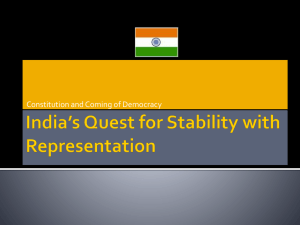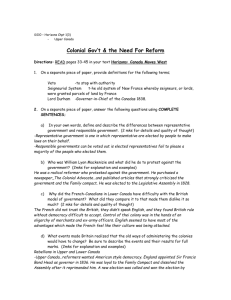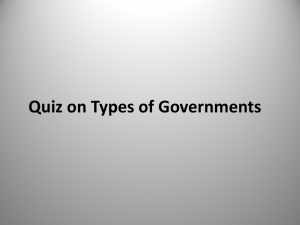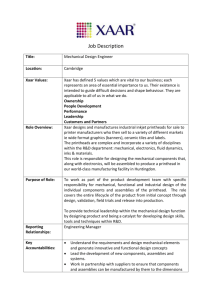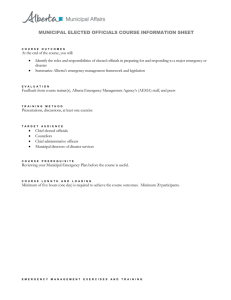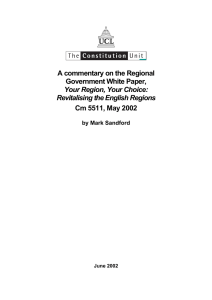Sports Development & City Leisure
advertisement
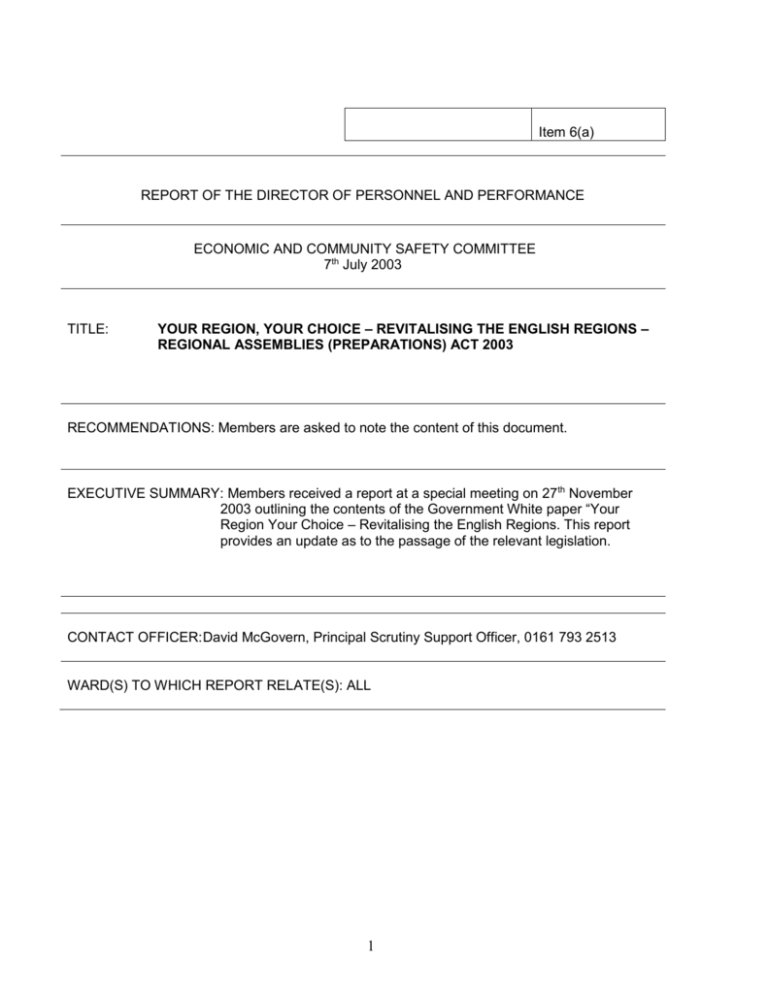
Item 6(a) REPORT OF THE DIRECTOR OF PERSONNEL AND PERFORMANCE ECONOMIC AND COMMUNITY SAFETY COMMITTEE 7th July 2003 TITLE: YOUR REGION, YOUR CHOICE – REVITALISING THE ENGLISH REGIONS – REGIONAL ASSEMBLIES (PREPARATIONS) ACT 2003 RECOMMENDATIONS: Members are asked to note the content of this document. MEND EXECUTIVE SUMMARY: Members received a report at a special meeting on 27th November 2003 outlining the contents of the Government White paper “Your Region Your Choice – Revitalising the English Regions. This report provides an update as to the passage of the relevant legislation. CONTACT OFFICER: David McGovern, Principal Scrutiny Support Officer, 0161 793 2513 WARD(S) TO WHICH REPORT RELATE(S): ALL 1 1. INTRODUCTION TO THE WHITE PAPER The white paper on the regions – “Your region, your choice: revitalising the English Regions” – was published on 9th May 2002. This briefing summarises the proposals set out in the main chapters of the white paper. The white paper also includes ten annexes providing background statistics and information, which have not been included in this summary. 2. KEY POINTS The white paper sets out the Government’s proposed route forward for the English regions outside London. It sets out plans for both those regions likely to choose to establish directly elected regional assemblies, and those unlikely to move in that direction. For those regions choosing directly elected assemblies the white paper sets out that: (1) A 'yes' vote will be needed in a referendum before an elected assembly can be established and the local government structure in that region will need to become 100 per cent unitary; (2) The Boundary Commission for England will be asked to review the local government structure in the region and recommend the 'most effective wholly unitary arrangements' before any referendum is held; (3) Local government restructuring will only go ahead where a region votes for an elected Assembly; and (4) The model of regional assembly envisaged is one with 25-35 directly elected members with Leader and Cabinet. The assembly would be funded largely by Government block grant but with the ability to raise a precept on the council tax and borrow funds, with limits. It would have a range of responsibilities focused on improving quality of life and prosperity for the region and drawn largely from current regional bodies. For regions unlikely to move to directly elected assemblies, the key changes are: (1) Increased responsibilities for Government Offices and regional chambers to 'join up' regional policy; (2) A stronger regional input into national policy making and spending decisions; (3) The introduction of regional spatial strategies to replace the existing regional planning guidance as a stronger planning tool. 2 Contents of the white paper The white paper has nine chapters and ten annexes Chapter 1 Understanding the regional dimension Chapter 2 Strengthening the English Regions Chapter 3 A vision for regional democracy Chapter 4 The functions of elected regional assemblies Chapter 5 Funding of elected regional Assemblies Chapter 6 Boundaries and electoral system for regional assemblies Chapter 7 The constitution of elected regional assemblies Chapter 8 Working relationships for effective English regions Chapter 9 Process for implementation Annex A Regional fact sheets (for the English regions outside London) Annex B Regional comparisons Annex C Public bodies active in the North East Annex D Existing regional strategies Annex E Regional arrangements for other countries Annex F Current functional Arrangements Annex G The Alternative Member System of proportional representation Annex H Powers and functions of the Greater London Assembly Annex I Glossary Annex J Bibliography 3 3. CURRENT SITUATION 3.1 On the 16th June 2003 the Office of the Deputy Prime Minister issued a press statement providing an update on the current situation and the progress on the primary legislation i.e. The Regional Assemblies (preparations) Act 2003. 3.2 It was announced that, as a precursor to ordering referendums on elected regional assemblies, the Deputy Prime Minister is directing the Boundary Committee for England to undertake local government reviews in the following Regions – the North East, the North West and Yorkshire and the Humber. The reviews are intended to provide recommendations for the reorganization of all existing two-tier areas in those regions. 3.3 The Boundary Committee were directed to begin their reviews on 17th June 2003 and make their final recommendations by 25th May 2004. Based on the committee’s recommendations the Government will put options for wholly unitary local government to the voters in two-tier areas at the same time as referendums for elected regional assemblies are held. Implementation of any local government reorganization will only happen: (a) after local people have, through a referendum, expressed a preference on the options for unitary local structures; and (b) if, following a referendum about an elected regional assembly, the Government proposes the establishment of such an assembly for the region concerned. 3.4 The Act requires the Boundary Committee to undertake reviews on the assumption that there is an elected assembly for the region. The Boundary Committees options for single tier local government in a County area may include the addition of some or all of two-tier areas to that of existing unitary authorities. 3.5 When undertaking the reviews the committee are required to consult with local authorities and other interested parties before arriving at their final recommendations. They are also required to have regard to: the need to reflect the identities and interests of local communities; the need to secure effective and convenient local government; and guidance issued by the Secretary of State. 4. REGIONAL REFERENDA 4.1 Following on from the above announcement the Deputy Prime Minister released a statement indicating that three of the English Regions had been chosen to hold the first referendums for elected regional assemblies. The regions chosen included our own, the North West, together with the North East and Yorkshire and the Humber. It is hoped that the level of interest shown in these regions will indicate whether referenda should be held in the remaining five regions. 5. CONCLUSION Members will continue to receive updates on the progress of this work. 4


